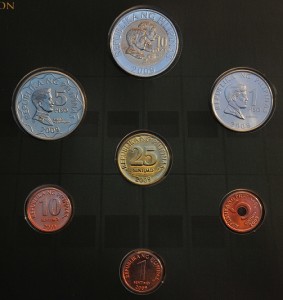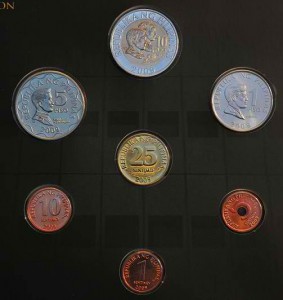By JENNY S. SANTIAGO
 IF you gather all the Philippine coins circulating in the market today, their combined weight would be equivalent to 24,183 jeepneys, according to the Bangko Sentral ng Pilipinas.
IF you gather all the Philippine coins circulating in the market today, their combined weight would be equivalent to 24,183 jeepneys, according to the Bangko Sentral ng Pilipinas.
Philippine coins in circulation run into billions–15.74 billion pieces to be exact. BSP says the huge quantity of coins is such that there are 193 coins for every Filipino. That is the ratio of coins to the present population of 92.2 million, excluding the 11 million overseas Filipinos.
This year, the BSP produced some 140 million more pieces of coins valued at about P1 billion.
Still, a coin shortage is being felt in some parts of the country, including Metro Manila.
People continue to be shortchanged by many department stores, groceries, drugstores, fastfood chains and retail stores because of the lack of coins, particularly the low-denominated 25-, 10-, five- and one-sentimo (centavo) coins.
But consumers have become so used to some business establishments of rounding off to the next higher value the prices of goods (e.g., P1.50 or P1.95 becomes P2) that many no longer ask for their loose change. Instances when the prices are rounded off to the lower value are very rare.
In the past, cashiers would at least offer candies in lieu of the lack of coins, ask buyers for exact coins, or apologetically inform them of their lack of loose change. Today, most cashiers would not bother doing any of these.
Even some banks are reeling from the effects of the coin shortage. For instance, it has been reported that the Cebu Bankers Club already requested the BSP to increase the allocation of small-denominated coins in Central Visayas because the scarcity of coins is affecting bank transactions in the region.
In Metro Manila, even leading banks say they are short of sentimo coins. Some say they have similarly asked the BSP to increase their coin allocation.
VERA Files went to four different banks near a marketplace recently to see how much 25-sentimo coins they could exchange for peso bills. The result: The four banks only had P7, P12, P20, and P25 worth of 25-sentimo coins in hand, respectively.
Cashiers of a big drugstore and a fastfood restaurant in the same area said they could not give exact change to some customers because they also lack 25-sentimo coins. Even sari-sari stores and carinderias or turo-turos (small eateries selling an array of dishes) in a nearby public elementary school complained about the same problem.
Latest BSP statistics show that 89 percent of the 15.74 billion pieces of coins in circulation as of May 31 this year are low-denomination coins, 35 percent of which are 25-sentimo coins. There are eight coins for every one banknote or bill, the BSP reports.
BSP has produced newly designed banknotes for release starting next month way ahead of the new set of coins, which will be introduced two years later. The new banknotes feature Filipinos who played significant roles in the country’s history, world heritage sites and iconic natural wonders of the Philippines while the new coins will highlight national symbols.
“Clearly, the problem is not supply, but circulation (of coins)…the solution is efficient recirculation,” the BSP says in its multisectoral briefing on the National Coin Recirculation Program.
The BSP relaunched the program this year because the problem of lack of supply of coins has resurfaced. The coin recirculation program was initiated in 2006 to address what the BSP considers an “artificial coin shortage.”
Various sectors have again signed up to support the program. These include major retail organizations, transport groups, petroleum dealers, banks, tollway administrators, vendo machine operators and even the Catholic Church.
The church’s fundraiser Pondo ng Pinoy was pinpointed by the BSP two years ago as having inadvertently contributed to the lack of 25-sentimo coins. This prompted Manila Archbishop Gaudencio Cardinal Rosales to issue a circular reminding priests “not to hoard” and immediately remit coin collections for the project, which reached P330,499,429 last May.
Four years after the coin recirculation program was launched, the coin shortage still persists for the very same reasons identified by the BSP before: the common practice of keeping coins idle in piggy banks, drawers, wallets; the low regard for coins; unintentional hoarding by business establishments engaged in vending machines, videoke and slot machines; and lotteries.
The BSP pointed out that the unequal distribution of coins also contributes to the problem. It notes that there is an oversupply of higher-denominated coins (P1, P5, and P10) in provinces where jueteng, or the illegal numbers game, proliferates.
“More importantly, BSP has documented cases of illegal hoarding for melting/and or shipment to others countries for use of raw materials in the manufacture of computer chips,” it added.
The BSP found that one-peso coins are being smuggled to China and Korea where there is a high demand for copper and nickel used in the manufacture of bullets and tokens, aside from computer parts. On the other hand, the 25-sentimo coins are being melted and combined with other metals to produce more durable sinks.
It urged the public to make it a habit to regularly use coins to put them back in circulation so that the government can save millions of pesos from lower coin production.
Just remember that the maximum amount you can pay for a single transaction is P100 with your 25-, 10-, 5-, or 1-sentimo coins, and P1,000 with your P1-, P5-, or P10-coins pursuant to BSP Circular 357.
